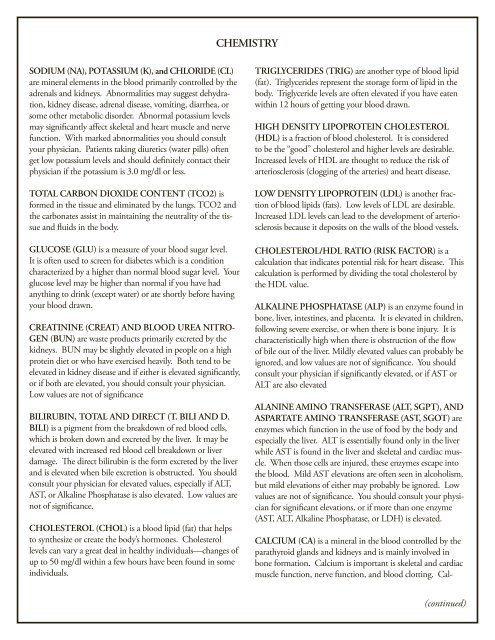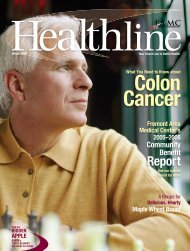Explanation of laboratory blood tests - Fremont Area Medical Center
Explanation of laboratory blood tests - Fremont Area Medical Center
Explanation of laboratory blood tests - Fremont Area Medical Center
Create successful ePaper yourself
Turn your PDF publications into a flip-book with our unique Google optimized e-Paper software.
CHEMISTRY<br />
SODIUM (NA), POTASSIUM (K), and CHLORIDE (CL)<br />
are mineral elements in the <strong>blood</strong> primarily controlled by the<br />
adrenals and kidneys. Abnormalities may suggest dehydration,<br />
kidney disease, adrenal disease, vomiting, diarrhea, or<br />
some other metabolic disorder. Abnormal potassium levels<br />
may significantly affect skeletal and heart muscle and nerve<br />
function. With marked abnormalities you should consult<br />
your physician. Patients taking diuretics (water pills) <strong>of</strong>ten<br />
get low potassium levels and should definitely contact their<br />
physician if the potassium is 3.0 mg/dl or less.<br />
TOTAL CARBON DIOXIDE CONTENT (TCO2) is<br />
formed in the tissue and eliminated by the lungs. TCO2 and<br />
the carbonates assist in maintaining the neutrality <strong>of</strong> the tissue<br />
and fluids in the body.<br />
GLUCOSE (GLU) is a measure <strong>of</strong> your <strong>blood</strong> sugar level.<br />
It is <strong>of</strong>ten used to screen for diabetes which is a condition<br />
characterized by a higher than normal <strong>blood</strong> sugar level. Your<br />
glucose level may be higher than normal if you have had<br />
anything to drink (except water) or ate shortly before having<br />
your <strong>blood</strong> drawn.<br />
CREATININE (CREAT) AND BLOOD UREA NITRO-<br />
GEN (BUN) are waste products primarily excreted by the<br />
kidneys. BUN may be slightly elevated in people on a high<br />
protein diet or who have exercised heavily. Both tend to be<br />
elevated in kidney disease and if either is elevated significantly,<br />
or if both are elevated, you should consult your physician.<br />
Low values are not <strong>of</strong> significance<br />
BILIRUBIN, TOTAL AND DIRECT (T. BILI AND D.<br />
BILI) is a pigment from the breakdown <strong>of</strong> red <strong>blood</strong> cells,<br />
which is broken down and excreted by the liver. It may be<br />
elevated with increased red <strong>blood</strong> cell breakdown or liver<br />
damage. The direct bilirubin is the form excreted by the liver<br />
and is elevated when bile excretion is obstructed. You should<br />
consult your physician for elevated values, especially if ALT,<br />
AST, or Alkaline Phosphatase is also elevated. Low values are<br />
not <strong>of</strong> significance.<br />
CHOLESTEROL (CHOL) is a <strong>blood</strong> lipid (fat) that helps<br />
to synthesize or create the body’s hormones. Cholesterol<br />
levels can vary a great deal in healthy individuals—changes <strong>of</strong><br />
up to 50 mg/dl within a few hours have been found in some<br />
individuals.<br />
TRIGLYCERIDES (TRIG) are another type <strong>of</strong> <strong>blood</strong> lipid<br />
(fat). Triglycerides represent the storage form <strong>of</strong> lipid in the<br />
body. Triglyceride levels are <strong>of</strong>ten elevated if you have eaten<br />
within 12 hours <strong>of</strong> getting your <strong>blood</strong> drawn.<br />
HIGH DENSITY LIPOPROTEIN CHOLESTEROL<br />
(HDL) is a fraction <strong>of</strong> <strong>blood</strong> cholesterol. It is considered<br />
to be the “good” cholesterol and higher levels are desirable.<br />
Increased levels <strong>of</strong> HDL are thought to reduce the risk <strong>of</strong><br />
arteriosclerosis (clogging <strong>of</strong> the arteries) and heart disease.<br />
LOW DENSITY LIPOPROTEIN (LDL) is another fraction<br />
<strong>of</strong> <strong>blood</strong> lipids (fats). Low levels <strong>of</strong> LDL are desirable.<br />
Increased LDL levels can lead to the development <strong>of</strong> arteriosclerosis<br />
because it deposits on the walls <strong>of</strong> the <strong>blood</strong> vessels.<br />
CHOLESTEROL/HDL RATIO (RISK FACTOR) is a<br />
calculation that indicates potential risk for heart disease. This<br />
calculation is performed by dividing the total cholesterol by<br />
the HDL value.<br />
ALKALINE PHOSPHATASE (ALP) is an enzyme found in<br />
bone, liver, intestines, and placenta. It is elevated in children,<br />
following severe exercise, or when there is bone injury. It is<br />
characteristically high when there is obstruction <strong>of</strong> the flow<br />
<strong>of</strong> bile out <strong>of</strong> the liver. Mildly elevated values can probably be<br />
ignored, and low values are not <strong>of</strong> significance. You should<br />
consult your physician if significantly elevated, or if AST or<br />
ALT are also elevated<br />
ALANINE AMINO TRANSFERASE (ALT, SGPT), AND<br />
ASPARTATE AMINO TRANSFERASE (AST, SGOT) are<br />
enzymes which function in the use <strong>of</strong> food by the body and<br />
especially the liver. ALT is essentially found only in the liver<br />
while AST is found in the liver and skeletal and cardiac muscle.<br />
When those cells are injured, these enzymes escape into<br />
the <strong>blood</strong>. Mild AST elevations are <strong>of</strong>ten seen in alcoholism,<br />
but mild elevations <strong>of</strong> either may probably be ignored. Low<br />
values are not <strong>of</strong> significance. You should consult your physician<br />
for significant elevations, or if more than one enzyme<br />
(AST, ALT, Alkaline Phosphatase, or LDH) is elevated.<br />
CALCIUM (CA) is a mineral in the <strong>blood</strong> controlled by the<br />
parathyroid glands and kidneys and is mainly involved in<br />
bone formation. Calcium is important is skeletal and cardiac<br />
muscle function, nerve function, and <strong>blood</strong> clotting. Cal-<br />
(continued)



